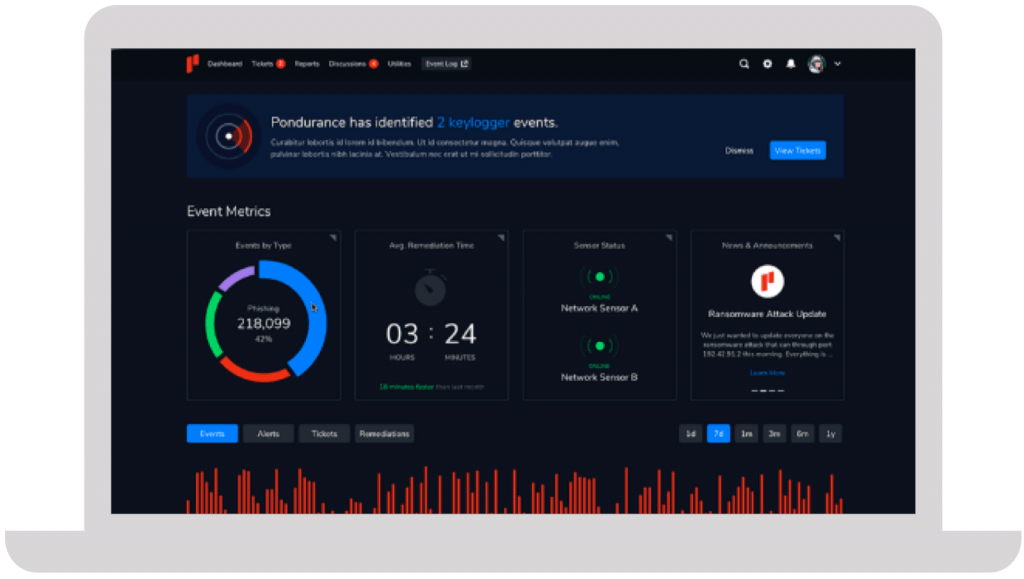

Shortage of cybersecurity talent
Security professionals are expensive and hard to retain
New compliance and regulation requirements
Undocumented processes in the event of an attack or breach
Security technology is expensive and hard to maintain
Technology alone can't deter motivated attackers
Lack of visibility across the enterprise
Difficulty managing multiple tools and investigating all alerts

We take a personalized approach to developing your cybersecurity program. Instead of an all-or-nothing approach like other MDR providers, Pondurance lets you pay for what you need, without sacrificing the visibility and transparency you want.
The number of data breaches continues to escalate, putting small businesses on high alert. Nowadays, any information that a business finds valuable is monetizable and a potential target for attack. Learn more in our eBook.
Your company has its own unique set of cyber risks. Though you can’t control the evolving cyber landscape, you can control your cybersecurity strategy. But what’s the best strategic approach to cybersecurity today? Learn more in our eBook.
Join us on-demand to discuss components of MDR and how to choose the right provider for your organization.







They immediately proved their value and earned our trust due to their immense expertise and guidance throughout the entire process.
Steve Long, CEO @ Hancock Health
In today’s digital world, the concept of interconnectivity stands as the cornerstone of modern existence. This interconnectivity weaves the fabric of our daily lives while simultaneously being the lifeblood of people and organizations in their pursuit of success.
Interconnectivity is essential for organizations today. It helps them access data, communicate with customers and suppliers, and operate smoothly. However, this inherent interconnectivity, while empowering, also has a significant downside — it introduces cybersecurity risks.
Cybersecurity risks, therefore, cast an ever-present shadow over organizations’ day-to-day operations. No entity, be it an individual or a large organization, is immune. Cybersecurity risks change with technology advancements. As technology progresses, so do the threats. This is a growing concern. Because of this fact, organizations must actively manage their cybersecurity needs to mitigate risk and comply with data security laws for their survival.
However, not many organizations can manage to actively monitor their cybersecurity risks and adjust their cybersecurity needs as needed. This is where cybersecurity firms like Pondurance step in. We have a dedicated team that provides customized cybersecurity solutions for organizations and actively adjusts these solutions to respond to emerging threats.
To sustainably and consistently remain guarded against cybersecurity risks, organizations must adopt a well-structured cybersecurity risk management framework. The importance of such a framework cannot be overstressed. A cybersecurity risk management framework acts as the linchpin upon which an organization’s cyber resilience hinges. Such a framework is indispensable for detecting, preventing, and responding to security incidents with precision and efficacy.
For organizations that lack an in-house ability to develop and run a cybersecurity risk management framework, these services can be outsourced by hiring outside help or contracting managed detection and response (MDR) services or equivalent cybersecurity risk management services from Pondurance. Our MDR services will give you a competitive advantage — because as we fight to help you with cybersecurity management, you are the boss, and all our solutions will be tailored to your specific needs.
When most people hear cybersecurity risks, they do not have an idea of what these risks are. Most people just use the term ‘hacked’ to indicate an identified risk. While this is a cybersecurity risk, it is too broad a term. Oftentimes, data breaches occur as part of a ransomware attack, and this is the first type of cybersecurity risk we’ll highlight.
In a ransomware attack, a hacker who gains access to a victim’s computer system deploys malicious software that encrypts the victim’s data and makes it inaccessible to them until a ransom is paid to the attacker. This is what everyone calls hacking, and indeed it is. In most of these cases, the perpetrators are smart enough to demand payment in popular cryptocurrencies like Bitcoin since such funds become un-seizable.
Unfortunately, due to continuous technological advancement, ransomware attacks have not only become increasingly common but more sophisticated, targeting high-profile organizations and, even worse, critical infrastructure providers such as healthcare institutions. With such organizations, hackers may also threaten to leak stolen sensitive information if a demanded ransom is not paid. To mitigate this risk, organizations, especially high-risk organizations, should ensure effective incident response plans and conduct regular data backups and employee training on identifying suspicious emails or links.
Ransomware makes up a larger group of malicious softwares — given the name malware. Malware, just like the name suggests, refers to any malicious or harmful program that is designed to perform notorious and unauthorized actions, such as stealing personal data or causing system disruption. The most common examples are viruses, worms, Trojans, adware, spyware, adware, and, more recently, crypto-mining malware, which was made to hijack computer resources for unauthorized cryptocurrency mining operations.
Another prevalent cybersecurity risk vector is phishing. This risk targets and exploits human weakness as opposed to technological vulnerabilities. Attackers target vulnerable individuals posing as legitimate entities such as banks or government agencies and deceive them into revealing sensitive information like their login credentials or financial details.
To counter this risk, organizations must cultivate a strong security culture by educating their employees on recognizing phishing attempts. They should also deploy advanced email filtering solutions that block malicious content.
Just like in the case of phishing, cybercriminals distribute malware through deceptive means by targeting unsuspecting people via compromised websites, fake software updates, and sending infected email attachments. Therefore, the best risk management strategies to deal with malware would be robust antivirus solutions coupled with proactive patch management.
Another lethal cybersecurity threat is insider threats, where employees or partners abuse their access to compromise data or systems. Insider threats can take various forms, including unauthorized data access or sharing, as well as deliberately introducing malware or backdoors into the network. Nefarious insiders may leak sensitive information, sell it on the black market, or use it for personal gain. Insiders are particularly dangerous since they can perform stealth attacks that are uniquely challenging to detect and mitigate. As a result, organizations must implement robust security measures, monitoring systems, and employee training programs to mitigate the risks associated with insider threats.
Additionally, Distributed Denial of Service (DDoS) attacks, which involve overwhelming targeted online services with a flood of artificial traffic, also pose a threat to organizations’ digital infrastructure. While DDoS attacks are easy to detect, albeit because their consequences are crippling, external threat actors can also perform stealth attacks by way of Advanced Persistent Threats (APT). These forms of attack are very dangerous because when conducted by skilled adversaries, which they usually are, they can remain undetected in networks for extended periods creating room for adverse consequences.
Conducting risk assessment for cybersecurity is the core of cybersecurity risk management. Risk analysis assessments allow organizations to identify, evaluate, and prioritize potential risks. The outcome of this is that organizations can effectively manage their security posture while simultaneously minimizing the potential negative impacts that may arise from a cyber-incident. Because risk assessment is such a core aspect, at Pondurance, we pride ourselves on the fact that one of our core strengths lies in our ability to conduct thorough risk assessments and analyses for all organizations. Our team at Pondurance is proficient in just about any framework or methodology used to guide organizations through the risk assessment, including but not limited to the vendor risk management (VRM) process, penetration testing risk assessment, and the National Institute of Standards and Technology (NIST) cybersecurity risk assessment framework. So, what are these frameworks about?
The VRM process focuses on assessing and managing the risks associated with external partners who have access to an organization’s critical systems or sensitive data. This approach involves an organization exploring the risk profiles of each of their vendors and subsequently identifying, measuring, and reducing the risks associated with each of their vendors or partners. Organizations also go ahead and establish baseline security requirements for these vendors to adhere to throughout the partnership. These vendors are then routinely monitored by the organization to ensure they comply with the set baseline standards throughout the partnership.
Penetration testing risk assessment or ethical hacking, on the other hand, aims at uncovering vulnerabilities in an organization’s network infrastructure. It does this by simulating real-world attack scenarios within an organization’s system. This allows companies to identify their systems’ weaknesses and implement appropriate countermeasures before they face real attacks from perpetrators. For this approach to work, organizations must conduct regular penetration tests to guarantee they are always one step ahead of potential attackers by maintaining robust security measures.
Finally, the NIST cybersecurity risk assessment framework plays a major role in providing guidelines for organizations to follow when conducting assessments of their information security posture. The NIST assessment defines categories such as threat sources, vulnerabilities, impact assessments, and likelihood estimates – all of which are essential components to consider when determining the overall level of risk associated with a specific asset or system. This framework consists of five continuous and concurrent functions:
Identify
Protect
Detect
Respond
Recover
When these functions are consistently performed, organizations can remain protected from cyber threats.
Ultimately, conducting proper cyber risk assessments for cybersecurity is a must for businesses looking to protect not just their digital assets but also maintain their reputation. Of course, organizations achieve the best results when they apply the perfect risk assessment techniques to deal with their specific cybersecurity risks. Once again, this is where Pondurance shines. Our team of experts leverages its deep knowledge of the cybersecurity landscape to conduct the most effective risk assessments using the best techniques tailored to serve each organization’s needs.
If you can only have just one takeaway from this article, let it be this: In today’s constantly changing digital landscape, the significance of cybersecurity risk assessment services cannot be emphasized enough. Using the right assessment tools is everything, literally! While cyber threats continue to evolve, it is only through risk assessment that these risks can be identified, evaluated, and ultimately managed. To conduct a thorough analysis of an organization’s security posture, most organizations employ MDR consultants as they are skilled enough to provide actionable insights that help mitigate live risks. MDR consultants also ensure that companies comply with industry standards and regulations such as the General Data Protection Regulation (GDPR) and the Health Insurance Portability and Accountability Act (HIPAA). Remember, you can always get the top-of-the-line Pondurance services when you allow us to offer you our holistic MDR services in dealing with cybersecurity.
After assessing the potential cybersecurity risks in an organization, the next step is for organizations to develop a comprehensive cybersecurity risk management plan. This strategic document enables organizations to stay ahead of emerging threats while maintaining regulatory compliance. However, it has to be formally written so that the policies, processes, and controls necessary to protect an organization’s digital assets and sensitive information from cyber threats are ingrained into the organization’s strategic plans and operating procedures. The cybersecurity risk management plan should also be detailed and thus include fine details such as threat identification and prioritization approaches, incident response planning, risk mitigation strategies, employee training programs, and continuous monitoring activities.
Ultimately, effective cybersecurity risk management is vital for the long-term success of any business operating in today’s digital landscape. By adopting a robust cybersecurity risk management framework, prioritizing risks and controls, and measuring their progress through quantitative metrics, organizations can mitigate cyber threats more effectively and subsequently safeguard their critical assets. Moreover, even when they suffer from a cyber attack, organizations with a cybersecurity risk management plan can act swiftly to counteract the attack and reduce its potential impact. Therefore, as technology plays a central role in our everyday operations, it becomes more critical for organizations to actively manage cybersecurity risks. Contracting MDR consultants is undoubtedly one of the best ways to stay ahead of cybersecurity threats, and we dare say that at Pondurance, we are the best!